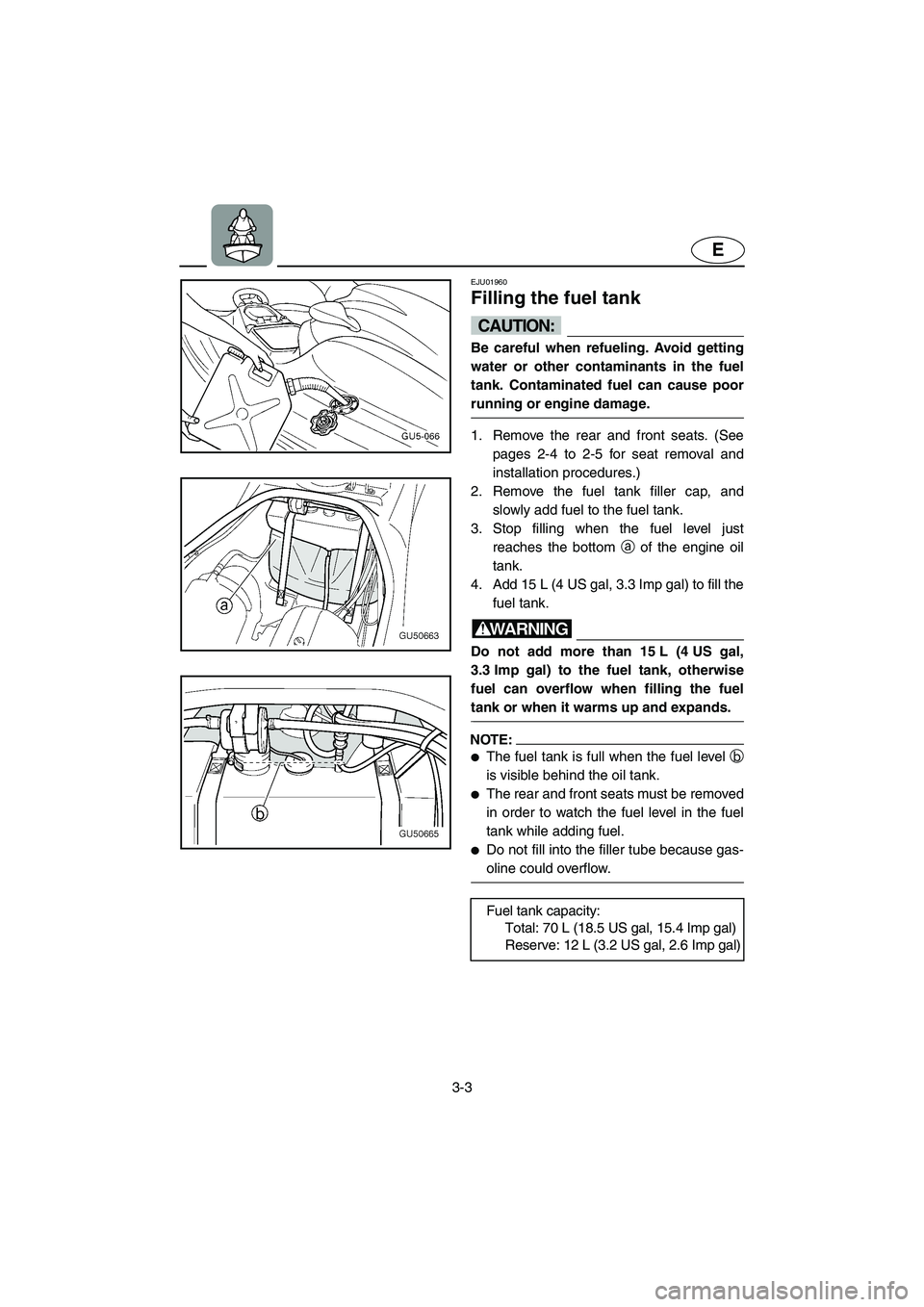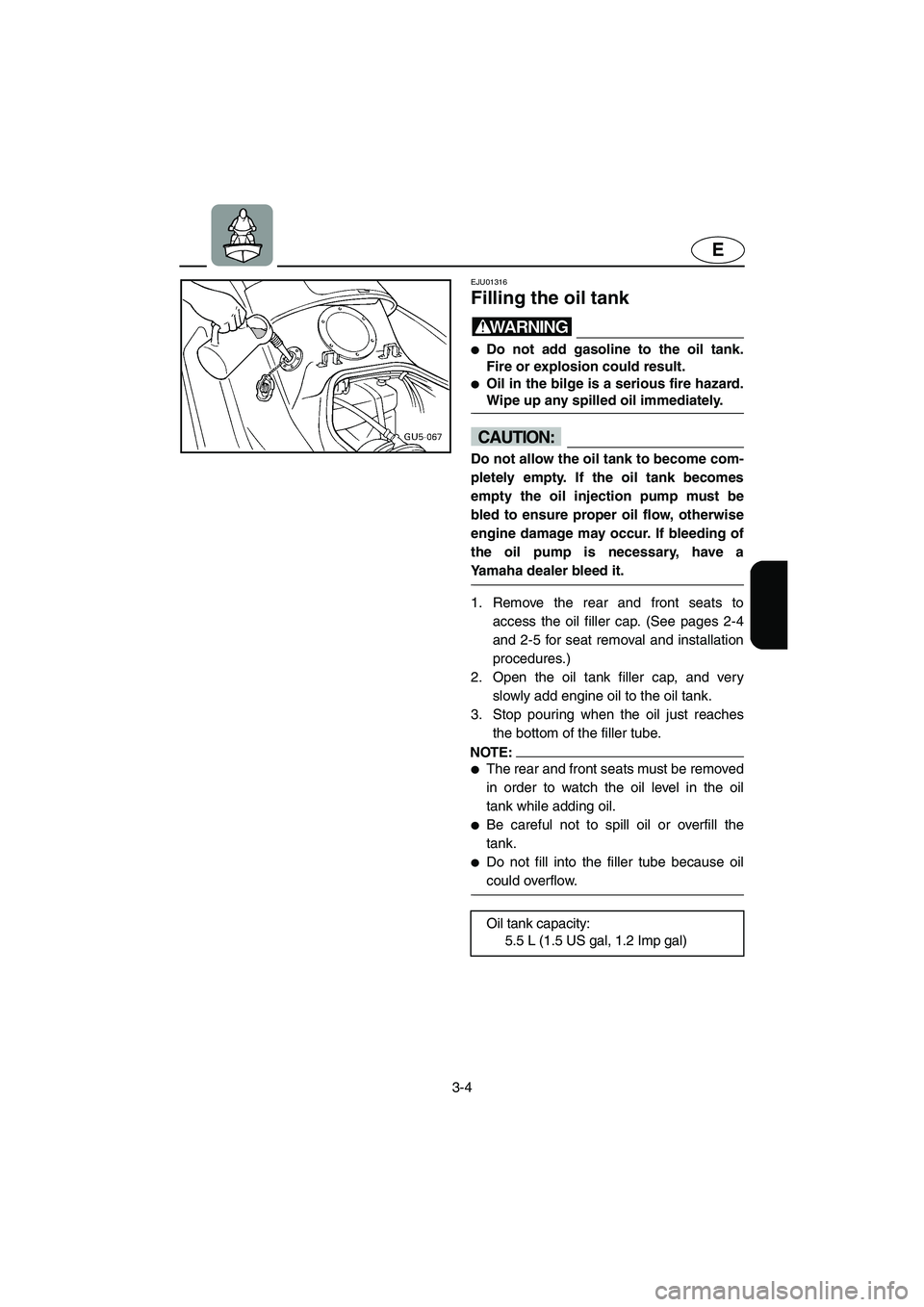Page 59 of 134
3-2
E
�If any gasoline spills onto your skin,
immediately wash with soap and
water. Change clothing if gasoline
spills on it.
@
CAUTION:@ Use only fresh gasoline that has been
stored in clean containers.
@
EJU01832
Gasohol
There are two types of gasohol: gasohol
containing ethanol and that containing meth-
anol.
Gasohol containing ethanol can be used
if ethanol content does not exceed 10% and
the fuel meets minimum octane ratings.
Gasohol containing methanol is not rec-
ommended by Yamaha because it can
cause fuel system damage or engine perfor-
mance problems.
EJU01044
2-stroke engine oil
If YAMALUBE 2-W is not available,
another 2-stroke engine oil with an NMMA-
certified TC-W3 rating may be used.Recommended gasoline:
Regular unleaded gasoline with
a minimum octane rating of
86 (Pump octane number) = (R+M)/2
90 (Research octane number)
Recommended engine oil:
YAMALUBE 2-W
UGU572.book Page 2 Wednesday, August 28, 2002 1:31 PM
Page 60 of 134

3-3
E
EJU01960
Filling the fuel tank
CAUTION:@ Be careful when refueling. Avoid getting
water or other contaminants in the fuel
tank. Contaminated fuel can cause poor
running or engine damage.
@
1. Remove the rear and front seats. (See
pages 2-4 to 2-5 for seat removal and
installation procedures.)
2. Remove the fuel tank filler cap, and
slowly add fuel to the fuel tank.
3. Stop filling when the fuel level just
reaches the bottom a of the engine oil
tank.
4. Add 15 L (4 US gal, 3.3 Imp gal) to fill the
fuel tank.
WARNING@ Do not add more than 15 L (4 US gal,
3.3 Imp gal) to the fuel tank, otherwise
fuel can overflow when filling the fuel
tank or when it warms up and expands.
@
NOTE:@ �The fuel tank is full when the fuel level b
is visible behind the oil tank.
�The rear and front seats must be removed
in order to watch the fuel level in the fuel
tank while adding fuel.
�Do not fill into the filler tube because gas-
oline could overflow.
@
Fuel tank capacity:
Total: 70 L (18.5 US gal, 15.4 Imp gal)
Reserve: 12 L (3.2 US gal, 2.6 Imp gal)
UGU572.book Page 3 Wednesday, August 28, 2002 1:31 PM
Page 61 of 134

3-4
E
EJU01316
Filling the oil tank
WARNING@ �Do not add gasoline to the oil tank.
Fire or explosion could result.
�Oil in the bilge is a serious fire hazard.
Wipe up any spilled oil immediately.
@
CAUTION:@ Do not allow the oil tank to become com-
pletely empty. If the oil tank becomes
empty the oil injection pump must be
bled to ensure proper oil flow, otherwise
engine damage may occur. If bleeding of
the oil pump is necessary, have a
Yamaha dealer bleed it.
@
1. Remove the rear and front seats to
access the oil filler cap. (See pages 2-4
and 2-5 for seat removal and installation
procedures.)
2. Open the oil tank filler cap, and very
slowly add engine oil to the oil tank.
3. Stop pouring when the oil just reaches
the bottom of the filler tube.
NOTE:@ �The rear and front seats must be removed
in order to watch the oil level in the oil
tank while adding oil.
�Be careful not to spill oil or overfill the
tank.
�Do not fill into the filler tube because oil
could overflow.
@
Oil tank capacity:
5.5 L (1.5 US gal, 1.2 Imp gal)
UGU572.book Page 4 Wednesday, August 28, 2002 1:31 PM
Page 62 of 134

3-5
E
EJU01346
Pre-operation checks
EJU01347
Pre-operation check list
Before operating this watercraft, perform the checks in the following check list. See the
accompanying text in this chapter for details on how to perform the checks.
WARNING@ If any item in the pre-operation check list is not working properly, have it inspected
and repaired before operating the watercraft, otherwise an accident could occur.
@
NOTE:@ Pre-operation checks should be made thoroughly each time the watercraft is used. This pro-
cedure can be completed in a short time. It is worth the time spent to assure safety and reli-
ability.
@
ITEM ROUTINE PAGE
Engine compartment Remove all seats to ventilate the engine com-
partment. Check for fuel vapors or loose electri-
cal connections3-6
Bilge Check for water and fuel residue and remove if
necessary3-7
Throttle Check that the throttle lever springs back 3-10
Steering system Check for proper steering system operation 3-10
Shift lever and reverse gate Check for proper operation 3-11
Fuel and oil Check fuel and oil level and add if necessary
Check hoses and tanks for leakage3-6
Water separator Check for water and drain if necessary 3-7
Battery Check electrolyte level and battery condition 3-8
Front and rear seats Check that the seats are properly secured 2-4–2-5
Hull/Deck Check the hull and deck for cracks or other dam-
age—
Jet unit Check for debris and remove if necessary 3-12
Fire extinguisher Check the condition and replace if necessary 3-9
Engine shut-off cord Check condition and replace is frayed or broken 3-12
Switches Check the start switch, engine stop switch and
engine shut-off switch for proper operation when
the watercraft is in the water3-13
Cooling water pilot outlet Check that water is discharged while the engine
is running and the watercraft is in the water3-13
Multifunction meter Check for warning indications and proper opera-
tion3-13
UGU572.book Page 5 Wednesday, August 28, 2002 1:31 PM
Page 63 of 134

3-6
E
EJU01048
Pre-operation check points
EJU01878
Engine compartment
Ventilate the engine compar tment before
each use.
To ventilate the engine compartment
remove the rear and front seats. (See pages
2-4 and 2-5 for seat removal and installation
procedures.) Allow the engine compartment
to remain open for a few minutes to allow
any fuel vapors to escape. Also, check for
loose electrical connections.
WARNING@ Failure to ventilate the engine compart-
ment could result in fire or explosion. Do
not start the engine if there is a fuel leak
or a loose electrical connection.
@
EJU01318
Fuel and oil systems
Check the fuel system for leakage, cracks
or malfunctions before each use. (See page
4-10 for check points and correct proce-
dures.)
1. Remove the fuel tank filler cap to release
any pressure that might have built up in
the fuel tank.
2. Remove the rear and front seats. (See
pages 2-4 to 2-5 for seat removal and
installation procedures.)
3. Check the fuel and oil levels in the tanks
and replenish if necessary. (See pages
3-3 and 3-4 for filling instructions.)
UGU572.book Page 6 Wednesday, August 28, 2002 1:31 PM
Page 71 of 134

3-14
E
EJU01836
Operation
WARNING@ Before operating your watercraft,
become familiar with all controls. Con-
sult your Yamaha dealer about any con-
trol or function you do not fully
understand. Failure to understand how
controls work could cause an accident or
prevent you from avoiding an accident.
@
CAUTION:@ Make sure that the stern drain plugs are
securely tightened before launching the
watercraft.
@
EJU01888
Engine break-in
The engine break-in period is essential to
allow the various components of the engine
to wear and polish themselves to the correct
operating clearances. This ensures proper
performance and promotes longer compo-
nent life.
CAUTION:@ �For the first tankful of operation, pre-
mix a 50:1 mixture of fuel and oil (in
addition to the oil in the oil tank).
�After break-in, use straight gasoline
for normal operation.
@
1. Launch the watercraft and start the
engine. (See page 3-16 for engine start-
ing procedures.)
2. Run the engine at the lowest possible
speed for 5 minutes.
UGU572.book Page 14 Wednesday, August 28, 2002 1:31 PM
Page 84 of 134

3-27
E
CAUTION:@ Be sure to remove the clip from the
engine shut-off switch, otherwise the
engine will overheat and engine damage
may occur.
@
1. Shut the engine off by removing the clip
from the engine shut-off switch.
2. Swim to the rear of the watercraft. Climb
onto the right side of the capsized water-
craft and place both feet on the rub rail
near the stern.
NOTE:@ If the port (left) side of the capsized water-
craft is tilting upward, first tilt the watercraft
so the port (left) side is down by using your
weight to press down on the rub rail.
@
3. Grasp the ride plate with your left hand
and place your right hand under the
intake grate.
4. Lean backwards and forcefully pull the
watercraft clockwise until it is upright.
CAUTION:@ Do not turn the watercraft over counter-
clockwise, otherwise water may leak into
the carburetor and engine and cause
damage.
@
5. Start the engine, and then head for
shore to inspect the engine for water
damage.
CAUTION:@ If the watercraft has been capsized for
5 minutes or more, air may have entered
the oil injection system. Leave the engine
off, or operate only at trolling speed, for
10 minutes after the watercraft has been
turned right-side up. This will allow any
air to bleed off.
@
UGU572.book Page 27 Wednesday, August 28, 2002 1:31 PM
Page 96 of 134

4-3
E
EJU01325
Lubrication
WARNING@ To reduce the risk of fire or explosion:
Never pour or spray gasoline, or any sub-
stance other than engine fogging oil
through the holes in the carburetor
silencer cover.
@
CAUTION:@ �Be sure to replace the caps securely
after fogging the engine. Otherwise
water could enter the engine and
cause damage.
�Do not attempt to run the engine at full
throttle or for more than 15 seconds
while the watercraft is out of the water,
otherwise the engine may overheat
and/or seize.
@
1. Open the silencer caps 1 on the
silencer.
2. Start the engine with the watercraft in a
well-ventilated area.
3. With the engine running at a fast idle,
quickly spray as much fogging oil as pos-
sible through the holes in the silencer
cover. Keep spraying until the engine
stalls (or a maximum of 15 seconds).
4. Install the caps securely.
5. Lubricate all cables such as the throttle,
choke, and steering cables.
NOTE:@ Use a suitable marine grease applicator to
pressure lubricate the cables and purge out
any moisture between the inner and outer
cables.
@
6. Lubricate the areas of the watercraft
specified under Lubrication points on
page 4-16.
UGU572.book Page 3 Wednesday, August 28, 2002 1:31 PM